Analysis of Topographic Feature Parameters of Dinosaur Valley Ring Tectonic Geomorphology Based on the Advanced Land Observing Satellite Digital Elevation Model (ALOS DEM)
Abstract
:1. Introduction
2. Materials and Methods
2.1. Study Area
2.2. Data Sources and Processing
2.3. Methods
2.3.1. Extraction of Major Ridgelines and Valley Lines
2.3.2. Surface Water System Network Extraction
2.3.3. Mean-Variable-Point Analysis Method
- (1)
- The average terrain relief of (2 × 2, 3 × 3, …, 48 × 48) under incremental windows is obtained based on the terrain relief formula, and then the unit terrain relief is calculated sequentially using the formula:where is the rectangular analysis window; is the topographic relief under the analysis window; is the average relief under the analysis window; and is the area under the analysis window (m2).
- (2)
- is taken logarithmically () to obtain the sample series .
- (3)
- The arithmetic mean and the sum of squared deviations for is computed:where is the arithmetic mean of all samples; is the total number of samples; is the total sum of squared deviations.
- (4)
- Let = 2, 3, …, , and for each divide the sample into 2 segments: , and , then compute the arithmetic mean for each segment of samples , , and :where is the difference between the sum of squared deviations of the two sample segments.
- (5)
- Calculate the expected value:
2.3.4. Selection of Optimal Terrain Feature Parameters
2.3.5. Extraction of Topographic Factors
3. Results and Analysis
3.1. Ridgeline and Valley Line Mapping Analysis
3.2. Characterization of the Surface Water System Network
3.3. Slope and Slope Direction Analysis
3.4. Analysis of Relief Degree of Land Surface and Surface Roughness
4. Discussion
4.1. Selection of Data Sources
4.2. Selection of Research Methods
4.3. Limitations of the Study
5. Conclusions
- (1)
- This study determines that the optimal threshold for extracting the river network using ALOS DEM in this area is 150. The river network displays a characteristic dendritic pattern. The number and length of rivers show an inverse relationship with their order. The observation that first-order streams constitute over half of the river network distribution implies that the study area experiences abundant and well-established surface runoff, with the likelihood of additional tributaries forming over time.
- (2)
- The procedural steps for extracting terrain characteristic parameters from ALOS DEM offer valuable insights for studying complex terrain. This study determines that the optimal analysis window for extracting terrain feature parameters in this area is 16 × 16, with an optimal statistical area of 0.04 km2. Conducting correlation analysis on terrain characteristic parameters can mitigate information redundancy. The optimal combination of parameters to describe the terrain characteristics in the study area includes slope, slope direction, surface undulation, and surface roughness.
- (3)
- Statistical methods prove effective in analyzing the outcomes of terrain characteristic parameters. In this study, the slope gradient primarily spans from 0° to 56.59° and is characterized by slopes and steep inclines. Landslide-prone areas constitute 9.876% of the entire area. The slope direction exhibits uneven distribution, with the southeast slope representing the majority and a lower percentage of flat land overall. The predominant landform is hilly, with the majority of terrain exhibiting low roughness.
- (4)
- GIS visualization methods excel in emphasizing the spatial distribution of topographic features. The study area exhibits a generally intricate topography, characterized by a descent in elevation from northeast to southwest and prominent ring-like features. The ridgelines and valley lines exhibit distinct double-ring features reminiscent of a “heart” shape, radiating outward in the ring area. The topographic parameters are notable on the outer side of the ring ridge, featuring high slope values, surface relief, and surface roughness, diminishing from the inner to the outer ring.
- (5)
- Extracting topographic feature information in the intricate mountain environment of the plateau utilizing ALOS DEM data, offers advantages in terms of scale, non-contact, and ease of acquisition. This approach provides high-precision foundational data for research in topographic feature identification, measurement, and analysis.
Author Contributions
Funding
Institutional Review Board Statement
Informed Consent Statement
Data Availability Statement
Acknowledgments
Conflicts of Interest
Abbreviations
| GIS | Geographic Information System |
| GF-2 | Gaofen-2 satellite |
| DEM | Digital Elevation Model |
| ALOS | Advanced Land Observing Satellite |
| PALSAR | Phase Array type L-band Synthetic Aperture Radar |
| RTC | Radiometric Terrain Correction |
| ALOS DEM | Advanced Land Observing Satellite Digital Elevation Model |
| ASTER | Advanced Spaceborne Thermal Emission and Reflection Radiometer |
| ASTER GDEM | Advanced Spaceborne Thermal Emission and Reflection Radiometer Global Digital Elevation Model |
| SRTM | Shuttle Radar Topography Mission |
| SRTM DEM | Shuttle Radar Topography Mission Digital Elevation Model |
| RS | Remote sensing |
| UAV | Unmanned Aerial Vehicle |
| NNDiffuse | Nearest Neighbor Diffusion |
| RIT | Rochester Institute of Technology |
| JAXA | Japan Aerospace Exploration Agency |
| RDLS | Relief Degree of the Land Surface |
References
- Carrera-Hernandez, J.J. Not all DEMs are equal: An evaluation of six globally available 30 m resolution DEMs with geodetic benchmarks and LiDAR in Mexico. Remote Sens. Environ. 2021, 261, 112474. [Google Scholar] [CrossRef]
- Deng, J.; Cheng, W.; Liu, Q.; Jiao, Y.; Liu, J. Morphological differentiation characteristics and classification criteria of lunar surface relief amplitude. J. Geogr. Sci. 2022, 32, 2365–2378. [Google Scholar] [CrossRef]
- Sreekesh, S. Generation of Geomorphometric Information Using Satellite Images for Climate Change Impact Studies. Geospat. Technol. Clim. Chang. 2014, 10, 261–277. [Google Scholar]
- Yang, L.; Yang, X.; Na, J. An Exploration of Loess Landform Development Based on Population Ecology Method. ISPRS Int. J. Geo-Inf. 2022, 11, 104. [Google Scholar] [CrossRef]
- Xiong, L.; Li, S.; Tang, G.; Strobl, J. Geomorphometry and terrain analysis: Data, methods, platforms and applications. Earth-Sci. Rev. 2022, 233, 104191. [Google Scholar] [CrossRef]
- Burrough, P.A.; McDonnell, R.A.; Lloyd, C.D. Principles of Geographical Information Systems; Oxford University Press: New York, USA, 2015. [Google Scholar]
- Lakshmi, S.E.; Yarrakula, K. Review and critical analysis on digital elevation models. Geofizika 2018, 35, 129–157. [Google Scholar] [CrossRef]
- Polidori, L.; El Hage, M. Digital elevation model quality assessment methods: A critical review. Remote Sens. 2020, 12, 3522. [Google Scholar] [CrossRef]
- Fang, L.; Liu, W.; Li, H. Terrain Feature Extraction and Analysis of the Yanwachuan Basin in Loess Tableland-gully Region Based on GIS. Res. Soil Water Conserv. 2010, 17, 7–11+289. [Google Scholar]
- Zhang, K.; Xiao, Y.; He, Z.; Gao, M. Topography features of Qilian Mountains nature reserve based on SRTM DEM. Arid. Land Geogr. 2020, 43, 1559–1566. [Google Scholar]
- Venkatesh, M.; Anshumali. A GIS-based assessment of recent changes in drainage and morphometry of Betwa River basin and sub-basins, Central India. Appl. Water Sci. 2019, 9, 157. [Google Scholar] [CrossRef]
- Zhang, J.; Wu, J.; Qin, G.; Yao, Z. Geomorphic features and morphological classification in Qinling-Bashan Mountains based on DEM. J. Yunnan Univ. (Nat. Sci. Ed.) 2021, 43, 1147–1155. [Google Scholar]
- SU, L.; GUO, Y.; WU, Y. Analysis of geomorphology of Niyang River Basin based on digital elevation model. Soil Water Conserv. Sci. 2020, 18, 12–21. [Google Scholar]
- Agarwal, K.; Prakash, C.; Ali, S.N.; Jahan, N. Morphometric analysis of the Ladhiya and Lohawati river basins, Kumaun Lesser Himalaya, India. Z. Fur Geomorphol. 2012, 56, 201. [Google Scholar] [CrossRef]
- Xiong, L.; Tang, G.; Yang, X.; Li, F. Geomorphology-oriented digital terrain analysis: Progress and perspectives. J. Geogr. Sci. 2021, 31, 456–476. [Google Scholar] [CrossRef]
- Wu, Z.H.; Zhang, Y.Q.; Hu, D.G. Neotectonics, active tectonics and earthquake geology. Geol. Bull. China 2014, 33, 391–402. [Google Scholar]
- Weidong, L.; Shu, G.; Xiping, Y.; Sha, G. Extraction and analysis of feature elements of micro-topography in southern margin of Dinosaur Valley. Bull. Surv. Mapp. 2021, 8, 48. [Google Scholar]
- Bi, R.; Gan, S.; Yuan, X.; Li, R.; Gao, S.; Yang, M.; Luo, W.; Hu, L. Multi-View Analysis of High-Resolution Geomorphic Features in Complex Mountains Based on UAV—LiDAR and SfM—MVS: A Case Study of the Northern Pit Rim Structure of the Mountains of Lufeng, China. Appl. Sci. 2023, 13, 738. [Google Scholar] [CrossRef]
- Sha, G.; Xiping, Y.; Shu, G.; Milong, Y.; Lin, H.; Rui, B. Local 3D scene fine detection analysis of circular landform on the southern edge of Dinosaur Valley. Arab. J. Geosci. 2021, 14, 1840. [Google Scholar] [CrossRef]
- Hu, L.; Gan, S.; Yuan, X.; Yang, M.; Gao, S.; Bi, R. Application of Remote Sensinc of Linear Features of Circular Structure in South of Lufeng Dinosaur valley based on GF-2. J. Geol. Hazards Environ. Preserv. 2022, 33, 77–81. [Google Scholar]
- Zhao, H.; Gan, S.; Yuan, X.; Hu, L.; Wang, J.; Liu, S. Application of a Fractional Order Differential to the Hyperspectral Inversion of Soil Iron Oxide. Agriculture 2022, 12, 1163. [Google Scholar] [CrossRef]
- Pan, T.; Guan, H.; He, W. GF-2 satellite remote sensing technology. Spacecr. Recovery Remote Sens. 2015, 36, 16–24. [Google Scholar]
- Zhang, D.-D.; Xie, F.; Zhang, L. Preprocessing and fusion analysis of GF-2 satellite Remote-sensed spatial data. In Proceedings of the 2018 International Conference on Information Systems and Computer Aided Education (ICISCAE), Changchun, China, 6–8 July 2018; pp. 24–29. [Google Scholar]
- Liu, Z.; Zhu, J.; Fu, H.; Zhou, C.; Zuo, T. Evaluation of the Vertical Accuracy of Open Global DEMs over Steep Terrain Regions Using ICESat Data: A Case Study over Hunan Province, China. Sensors 2020, 20, 4865. [Google Scholar] [CrossRef]
- Khadri, S.; Pande, C.B. Remote sensing and gis applications of geomorphological mapping of Mahesh river basin, Akola & Buldhana districts, Maharashtra, India using multispectral satellite data. Indian Streams Res. J. 2014, 4, 1–7. [Google Scholar]
- Wu, H.; Liu, X.; Li, Q.; Hu, X.; Li, H. The Effect of Multi-Source DEM Accuracy on the Optimal Catchment Area Threshold. Water 2023, 15, 209. [Google Scholar] [CrossRef]
- Strahler, A.N. Quantitative analysis of watershed geomorphology. Eos Trans. Am. Geophys. Union 1957, 38, 913–920. [Google Scholar]
- LIU, Y.; ZHAO, T.; University, D. Method for extraction of relief amplitude of abandoned quarry based on change point method. Res. Soil Water Conserv. 2016, 23, 269–273. [Google Scholar]
- Zhang, X.; Cai, H.; Tu, H. Impact of Landscape Pattern on River Water Quality Based on Different Topographic Relief Areas: A Case Study of Chishui River Basin in Southwest China. Sustainability 2023, 15, 1476. [Google Scholar] [CrossRef]
- Liu, X.; Gong, J.; Zhou, Q.; Tang, G. A Study of Accuracy and Algorithms for Calculating Slope and Aspect Based on Grid Digital Elevation Model(DEM). Acta Geod. Cartogr. Sin. 2004, 33, 258–263. [Google Scholar]
- Demek, J. Manual of Detailed Geomorphological Mapping; IOS Press: Amsterdam, The Netherlands, 1984; pp. 27–28. [Google Scholar]
- Tang, G.; Song, J. Comparison of Slope Classification Methods in Slope Mapping from DEMs. J. Soil Water Conserv. 2006, 2, 157–160+192. [Google Scholar]
- Ren, D.; Zheng, D. Design of Terrain Information Extraction Scheme Based on GIS Platform: Take Suide County of Yulin City as an Example. Geomat. Spat. Inf. Technol. 2017, 40, 10–12+16+20. [Google Scholar]
- Mo, S. Study on digital landform patterns based on DEM in Qinling Mts. J. East China Norm. Univ. (Nat. Sci.) 2008, 2, 8–14. [Google Scholar]
- Su, Q.; Liang, M.; Yuan, D.; Xie, H.; Wu, Z. Geomorphic Features of the Bailongjiang River Drainage Basin and lts Relationship with Geological Disaster. Earth Sci. Inform. 2016, 41, 1758–1770. [Google Scholar]
- Rajasekhar, M.; Raju, G.S.; Raju, R.S. Morphometric analysis of the Jilledubanderu river basin, Anantapur District, Andhra Pradesh, India, using geospatial technologies. Groundw. Sustain. Dev. 2020, 11, 100434. [Google Scholar] [CrossRef]
- Wu, C.; Li, X.; Chen, W.; Li, X. A review of geological applications of high-spatial-resolution remote sensing data. J. Circuits Syst. Comput. 2020, 29, 2030006. [Google Scholar] [CrossRef]
- Huang, J.; Wei, L.; Chen, T.; Luo, M.; Yang, H.; Sang, Y. Evaluation of DEM Accuracy Improvement Methods Based on Multi-Source Data Fusion in Typical Gully Areas of Loess Plateau. Sensors 2023, 23, 3878. [Google Scholar] [CrossRef] [PubMed]
- Grecu, F. Geomorphological Map of the Prahova Subcarpathians (Romania). J. Maps 2009, 5, 108–116. [Google Scholar] [CrossRef]
- Hu, L.; Gan, S.; Yuan, X.; Yang, M.; Gao, S.; Bi, R.; Li, Y. Analysis of geomorphologic features of the circular structure in the south of Lufeng Dinosaur Valley. Earth Sci. Inform. 2022, 15, 455–464. [Google Scholar]
- Li, W.; Wang, P.; Ding, Z.; Li, P.; Liao, Z.; Hua, H.; Li, Y. Geomorphic Features of Wumeng Mountain National Nature Reserve Based onALOS DEM. Trop. Geogr. 2023, 43, 1390–1399. [Google Scholar]
- Arfa-Fathollahkhani, A.; Ayyoubzadeh, S.A.; Shafizadeh-Moghadam, H.; Mianabadi, H. Spatiotemporal Characterization and Analysis of River Morphology Using Long-Term Landsat Imagery and Stream Power. Water 2022, 14, 3656. [Google Scholar] [CrossRef]
- Bonilla-Sierra, V.; Scholtes, L.; Donzé, F.; Elmouttie, M. Rock slope stability analysis using photogrammetric data and DFN–DEM modelling. Acta Geotech. 2015, 10, 497–511. [Google Scholar] [CrossRef]
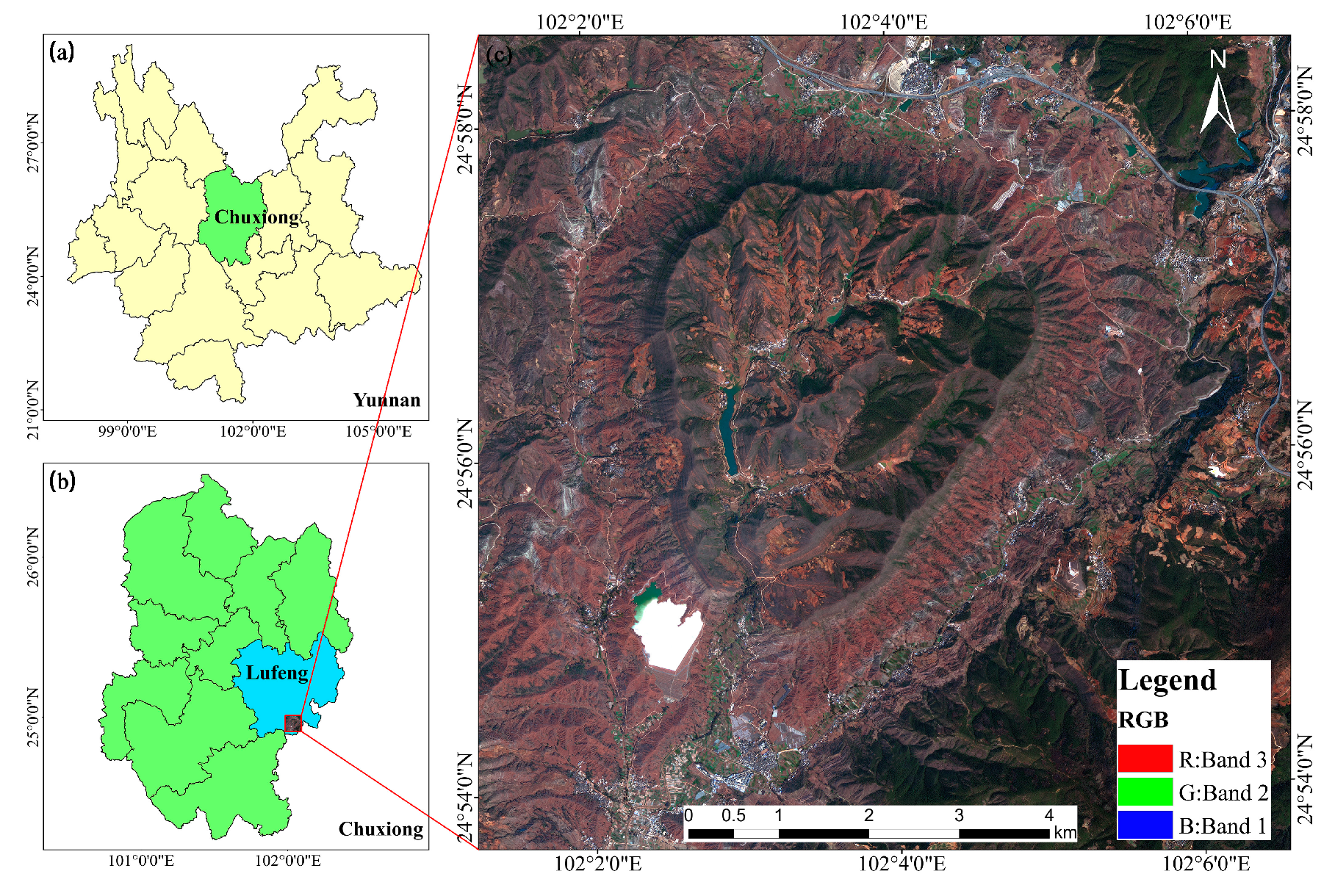
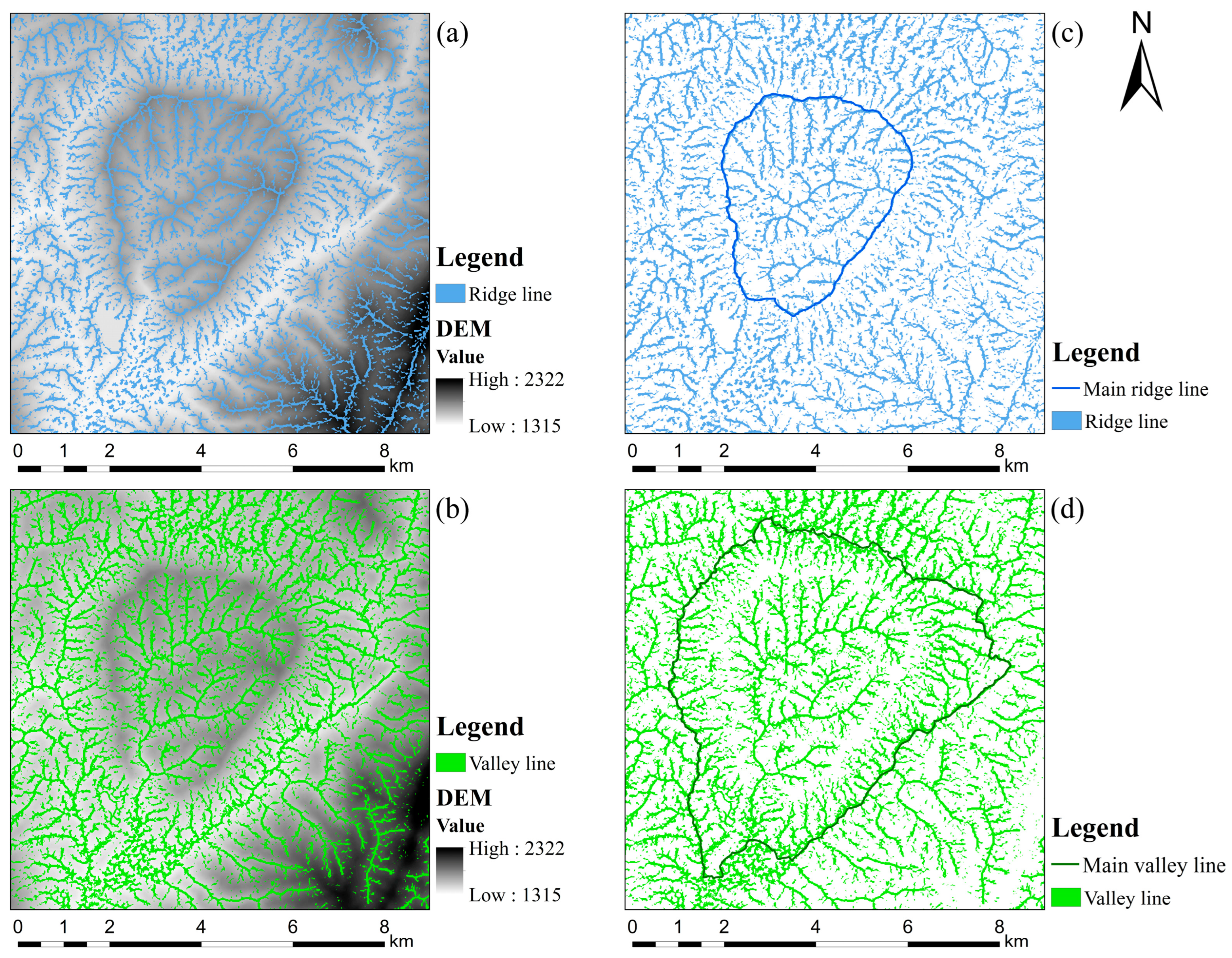
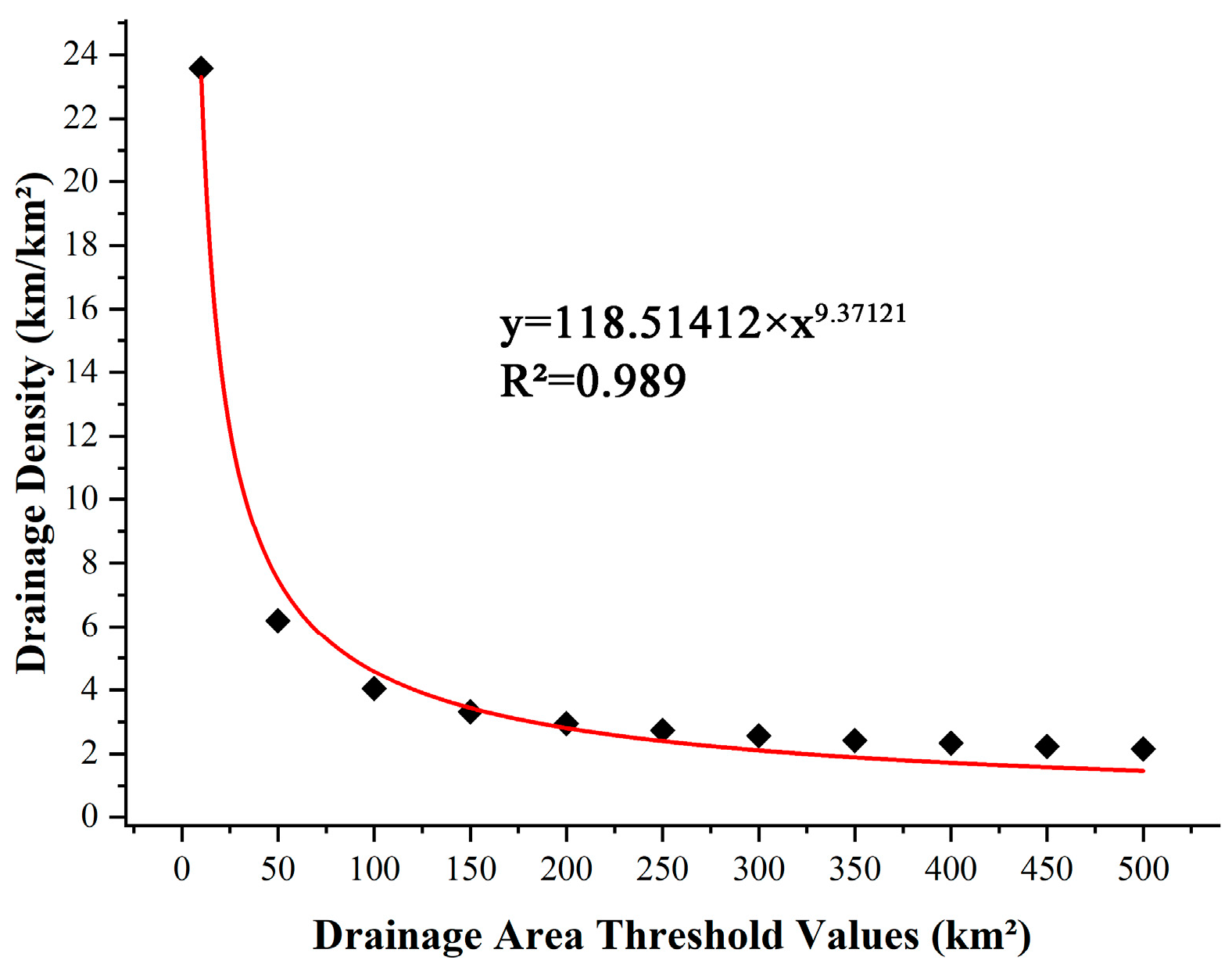
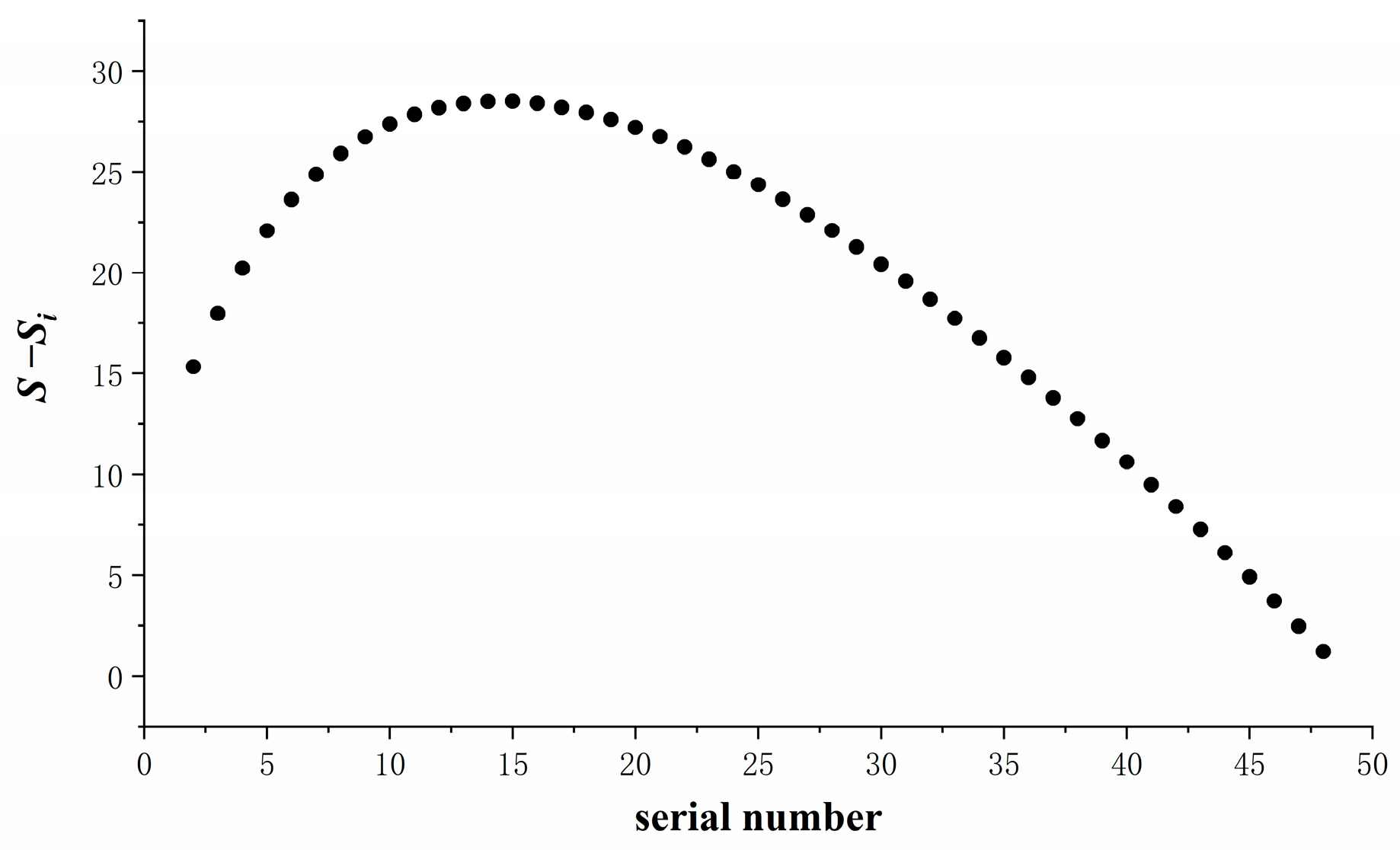
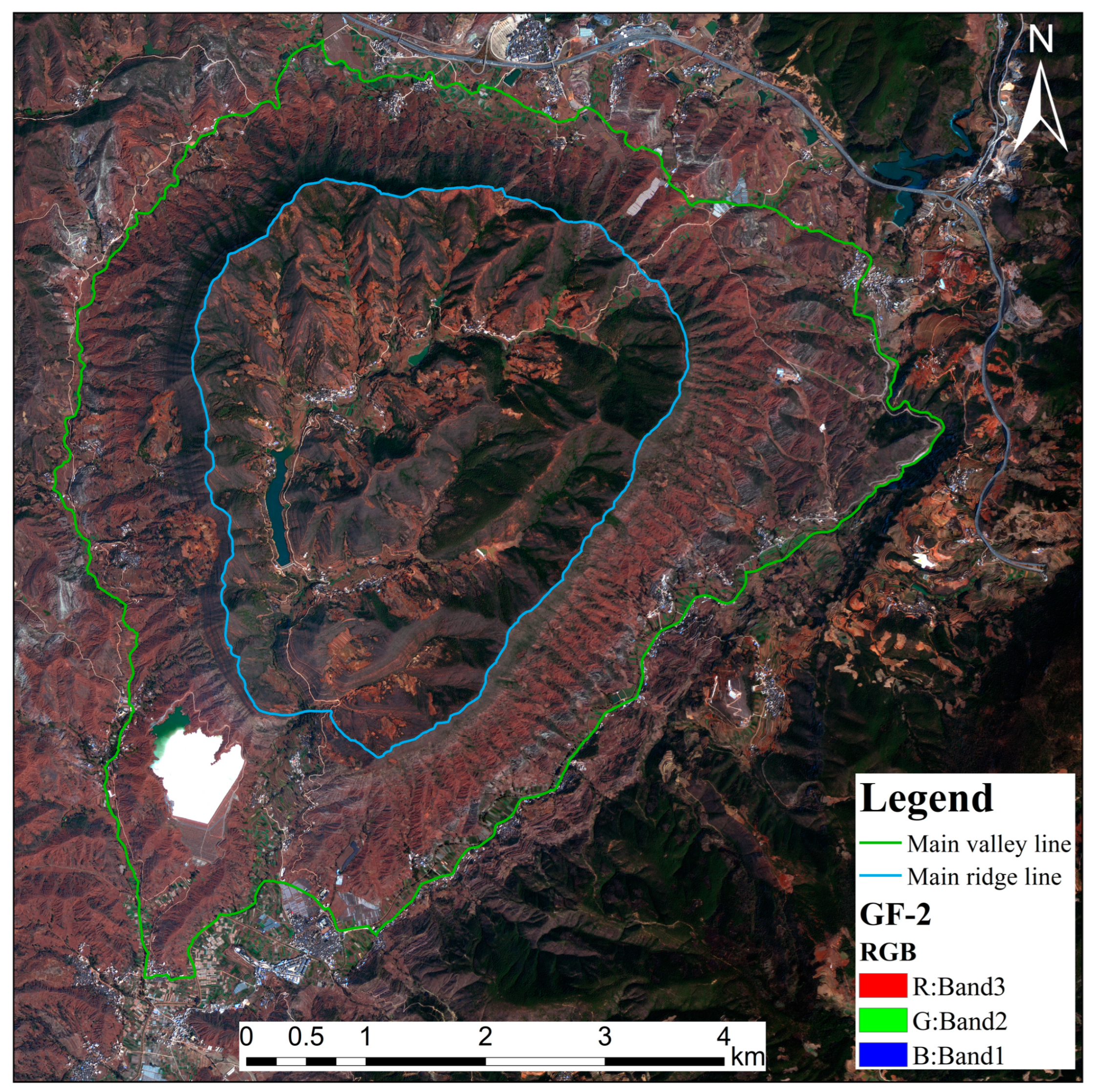

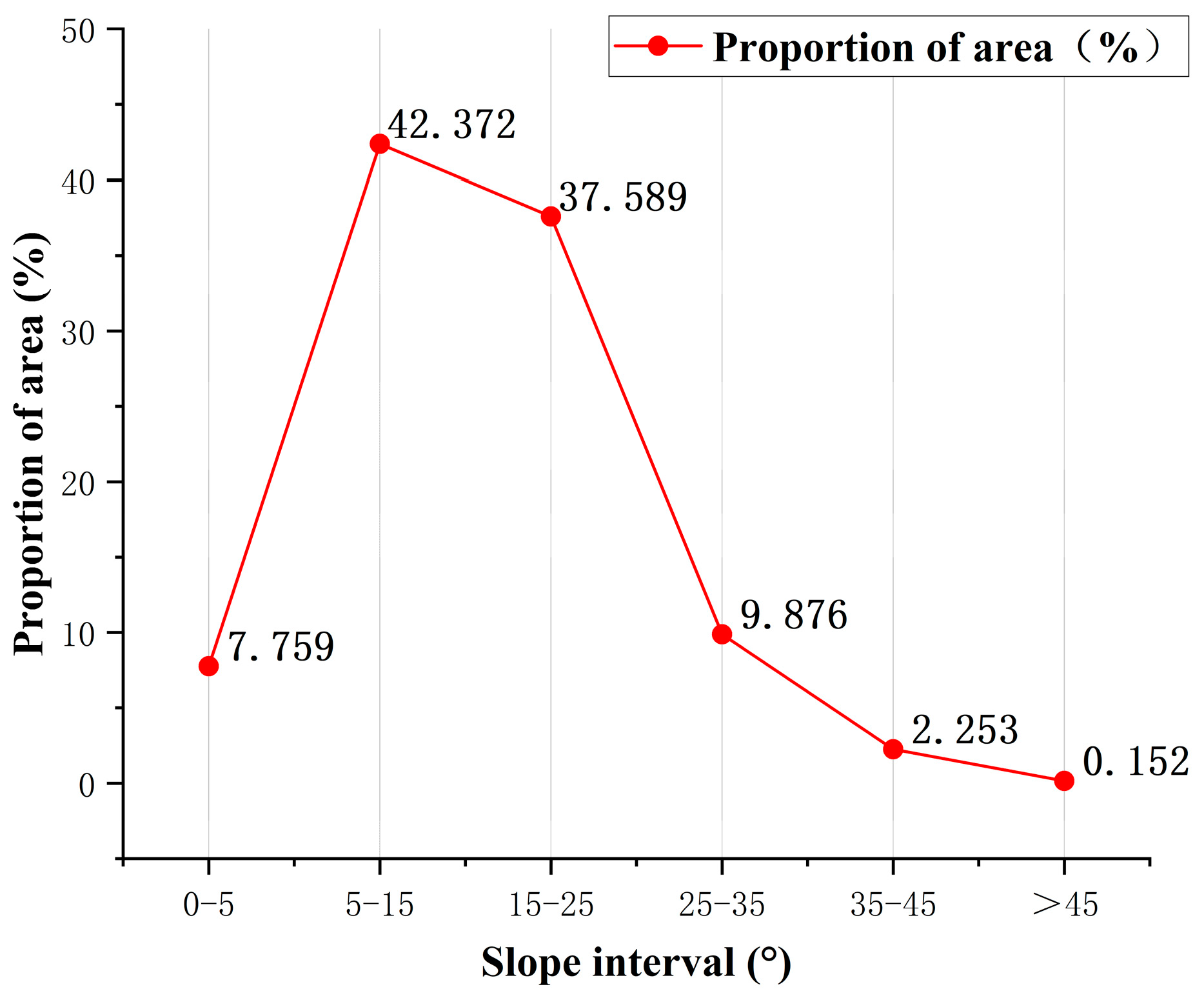

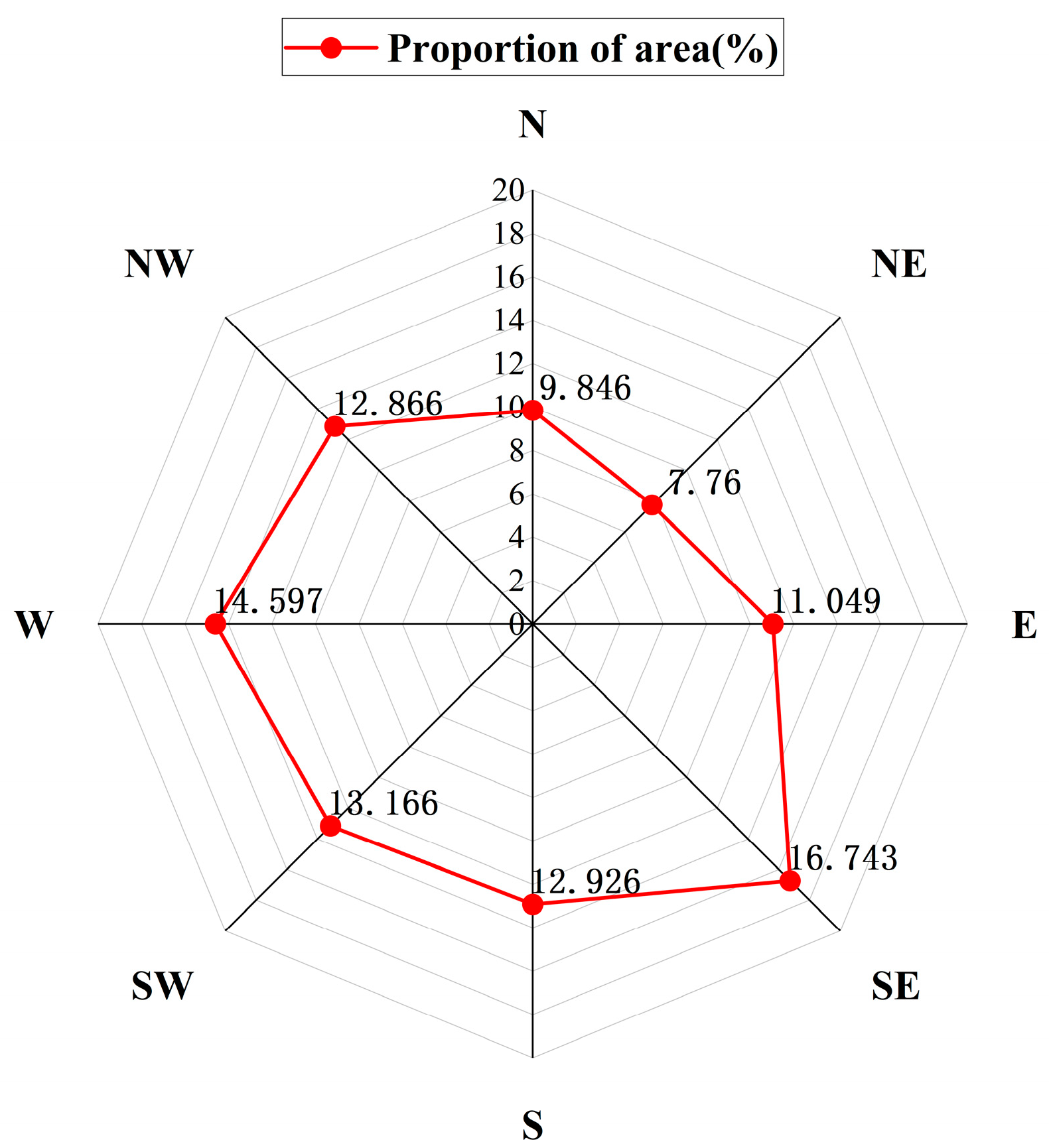

| Load | Spectral Range (μm) | Spatial Resolution (m) | Width (km) | Revisit Period (Day) | Coverage Period (Day) |
|---|---|---|---|---|---|
| Panchromatic camera | 0.45~0.90 μm | 0.8 m | 45 (Two cameras combination) | 5 | 69 |
| multispectral camera | 0.45~0.52 μm | 3.2 m | |||
| 0.52~0.59 μm | |||||
| 0.63~0.69 μm | |||||
| 0.77~0.89 μm |
| Feature Parameters | Slope | Slope Direction | RDLS | Surface Roughness | ECV | Surface Cut Depth |
|---|---|---|---|---|---|---|
| Slope | 1 | |||||
| slope aspect | 0.006 | 1 | ||||
| RDLS | 0.706 | 0.007 | 1 | |||
| Surface Roughness | 0.925 | 0.037 | 0.672 | 1 | ||
| ECV | 0.770 | 0.013 | 0.970 | 0.736 | 1 | |
| Surface Cut Depth | 0.688 | 0.001 | 0.937 | 0.662 | 0.914 | 1 |
| Title | Area (km2) | Perimeter (km) | East-West Width (km) | North-South Length (km) |
|---|---|---|---|---|
| Inner Ring Line (R1) | 13.997 | 15.044 | 4.152 | 4.846 |
| Outer Ring Line (R2) | 34.750 | 27.919 | 7.459 | 7.863 |
| R1/R2 | 0.403 | 0.539 | 0.557 | 0.616 |
| Level | Ⅰ | Ⅱ | Ⅲ | Ⅳ | Ⅴ | Total |
|---|---|---|---|---|---|---|
| Number of rivers | 144 | 64 | 41 | 23 | 9 | 281 |
| Length of river (km) | 21.420 | 12.574 | 7.982 | 3.307 | 1.260 | 46.519 |
| Parameter | Indicator | Total Area (km2) | Percentage (%) |
|---|---|---|---|
| Relief Degree | Plains (<30 m) | 6.829 | 18.140 |
| Plateaus (30~50 m) | 12.589 | 33.441 | |
| Hills (50~100 m) | 15.431 | 40.991 | |
| Mountains (100~200 m) | 2.796 | 7.428 | |
| Surface Roughness | 1 (Low roughness) | 20.418 | 59.278 |
| 2 (Medium-low roughness) | 10.164 | 29.509 | |
| 3 (Medium-high roughness) | 3.046 | 8.844 | |
| 4 (High roughness) | 0.816 | 2.370 |
Disclaimer/Publisher’s Note: The statements, opinions and data contained in all publications are solely those of the individual author(s) and contributor(s) and not of MDPI and/or the editor(s). MDPI and/or the editor(s) disclaim responsibility for any injury to people or property resulting from any ideas, methods, instructions or products referred to in the content. |
© 2023 by the authors. Licensee MDPI, Basel, Switzerland. This article is an open access article distributed under the terms and conditions of the Creative Commons Attribution (CC BY) license (https://creativecommons.org/licenses/by/4.0/).
Share and Cite
Wei, Y.; Gan, S.; Yuan, X.; Hu, L.; Gao, S. Analysis of Topographic Feature Parameters of Dinosaur Valley Ring Tectonic Geomorphology Based on the Advanced Land Observing Satellite Digital Elevation Model (ALOS DEM). Appl. Sci. 2023, 13, 13137. https://doi.org/10.3390/app132413137
Wei Y, Gan S, Yuan X, Hu L, Gao S. Analysis of Topographic Feature Parameters of Dinosaur Valley Ring Tectonic Geomorphology Based on the Advanced Land Observing Satellite Digital Elevation Model (ALOS DEM). Applied Sciences. 2023; 13(24):13137. https://doi.org/10.3390/app132413137
Chicago/Turabian StyleWei, Ya, Shu Gan, Xiping Yuan, Lin Hu, and Sha Gao. 2023. "Analysis of Topographic Feature Parameters of Dinosaur Valley Ring Tectonic Geomorphology Based on the Advanced Land Observing Satellite Digital Elevation Model (ALOS DEM)" Applied Sciences 13, no. 24: 13137. https://doi.org/10.3390/app132413137






